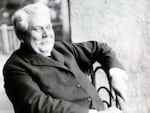
Sam Hill
The Oregon Historical Society
Sam Hill had great dreams for the Pacific Northwest, and himself. Out of the hardscrabble, do-it-yourself communities of loggers, farmers and ranchers that typified 19th-century Oregon, Hill envisioned a new society built on progress and human ingenuity. He championed grand roadways, built monumental symbols for peace and dared to imagine a farming utopia on the Columbia River. His life was etched with hard fought triumphs and colossal failures, but his enduring devotion to progress made him one of the most important and legendary figures in Oregon’s history.
Sam Hill (1857-1931) was nearly 40 years old when he first saw the wonders of the Pacific Northwest. Before that, he was a railroad man working for the Great Northern Railway in Minneapolis. Around the turn of the 20th century, Hill ventured to the Northwest to manage the company’s business interests there. He saw the ocean, mountains and great rivers and fell in love with the region.
Hill believed that good roads were essential for a society to thrive. He became a self-taught expert on the subject and began a public relations campaign to build a paved highway through the Columbia River Gorge despite the popular belief that the topography was too difficult and too unstable for a highway.
He hoped such a road would help in building another of his dreams — a farming utopia on the Columbia River. He purchased 6,000 acres about 100 miles east of Portland and began building a community he called Maryhill, after his daughter. But Hill had set Maryhill too far east where the meager annual rainfall couldn’t support the intensive farming he imagined.
The failure did not defeat Sam Hill. Early in 1913, he convinced the Oregon legislature to build the Columbia River Highway that was immediately hailed as an engineering masterpiece. The success inspired Hill to do more. He was involved with the construction of the Pacific Highway (Hwy 99), Highway 101 along the coast and a road to Crater Lake.
Highways weren't Hill's only passion. He built two of the most unusual monuments to peace in America: A replica of Stonehenge stands on his Maryhill estate as a memorial to local men who gave their lives in World War I. Hill also helped finance the Peace Arch in Blaine Washington, a huge symbol on the border between the U.S. and Canada, commemorating peace between the two nations.
By 1920, Sam Hill had become an international celebrity. But folks at home would still point to his failure at Maryhill, known locally as “Hill’s folly on the Columbia.”
At the suggestion of a friend, Hill drafted a bold plan to turn his abandoned farmhouse into a museum. He initiated a campaign to collect works of art from his friends around the world and invited Queen Marie of Romania to dedicate the fledgling museum in November 1926. Today, the Maryhill Museum of Art is home to original works by Rodin, rare Native American artifacts and a collection of European furniture and paintings.
Some say that Sam Hill was a visionary who gave his life and fortune to the people of the Pacific Northwest. Others believe he was a well-financed dreamer who wasted his fortune in the pursuit of fame. In the end, Sam Hill was both.
Queen Marie’s dedication speech at Maryhill Museum may explain Sam Hill best: “Sometimes the things dreamers do seem incomprehensible to others, and the world wonders why dreamers do not see the way others do.”
Resources
Books
Sam Hill: The Prince of Castle Nowhere by John E. Tuhy. 1983
Web
Oregon Department of Transportation — Historic Columbia River Highway
The official site of the peace arch, located in Blaine, WA
Broadcast Date: November 6, 2006